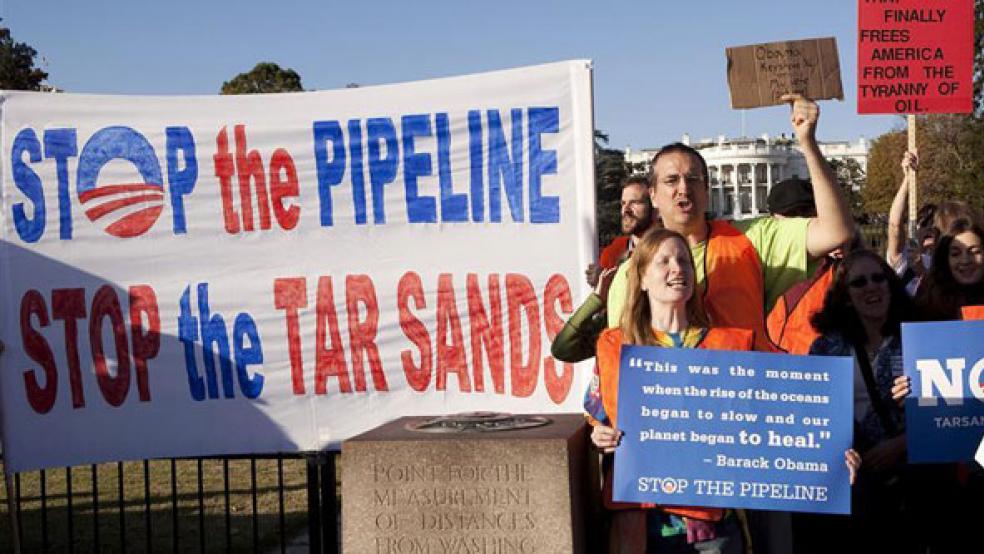How many votes does President Obama hope to win from environmentalists? More, apparently, than from construction workers. That would appear to be the calculus behind the decision of the White House to deny approval of the Keystone XL oil pipeline, which has been vehemently opposed by environmentalists, a key Obama constituency. A constituency, it should be said, whose enthusiasm has waned as the president failed to deliver on cap-and-trade and, more recently, prevented EPA head Lisa Jackson from imposing draconian new ozone limits. The administration had already punted on the hot-button Keystone project, deferring a decision until after the 2012 election, but Congress included a provision in the recent payroll tax agreement that forced Obama’s hand, demanding an up or down decision by February 21.
In denying the pipeline permit, the president risks appearing indecisive (the State Department left open the notion that a refigured route could lead to approval as early as the first quarter of 2013) and indifferent to job creation even as 21 million Americans remain unemployed or underemployed.
It has been estimated that the $7 billion project would create more than 20,000 construction jobs, as many as 100,000 “spin-off jobs” and raise over half a billion in state and local taxes for the six states through which it would pass. With Chief of Staff Bill Daley, a supposed agent of pro-business moderation, on his way out the door, the decision also bolsters the view that the president is clinging to his populist Big Government, anti-private sector, higher taxes approach – despite his drubbing in the 2010 midterm elections.
More to the point, the decision will put the president once again on a tightrope, balancing the needs of the country against the needs of the special interests that support him. The green lobby has been a major backer of Obama, but so have unions. Pipeline News reported in 2010 that four unions, “representing 2.6 million workers, sent a letter in October to Secretary of State Hillary Clinton urging approval for the project.”
More recently, the Teamsters, the International Brotherhood of Electrical Workers, the Laborers’ International Union and the United Association of Plumbers and Pipe Fitters for the United States and Canada have come out in favor of the project. Others with conflicting interests, such as the Transport Workers Union, have been opposed.
Environmentalists oppose the project for two main reasons. First, the pipeline traverses sensitive aquifers in Nebraska, which heightens reasonable concerns about a possible spill; TransCanada has already agreed to reroute the line so as to avoid the Sand Hills region in question. The second line of attack is that the line will pump 700,000 barrels per day of crude derived from the tar sands of Alberta via a process that generates more pollution than conventional oil production. This is not a valid issue. If the oil is not shipped to the United States, it will be exported to China. One way or another, the oil from the tar sands will be produced.
President Obama has said the decision is “not a judgment on the merits of the pipeline” but rather “the arbitrary nature of a deadline that prevented the State Department from gathering the information necessary to approve the project and protect the American people." Since the proposal has been under review since 2008, this is an almost laughable claim. In 2009 the agency held 20 public meetings along the proposed pipeline route, it hired an environmental consulting firm to prepare the environmental impact statement (EIS), it issued a draft EIS in April 2010, held another 21 public meetings in the states impacted, received 8,000 written comments, issued a supplemental EIS on April 15, 2011 (just to bring home where your tax dollars are flowing), and then solicited and received over 200,000 additional comments. In July 2011, the State Department promised to issue a final environmental impact statement in mid-August, and then to host meetings in September on the topic in each of the six states involved. Following those sessions, the agency said it would hold a “final public meeting in Washington, D.C.”
The final EIS was in fact issued in August, and found few environmental problems with the Keystone XL project, cheering industry supporters. Nonetheless, the State Department said in its statement yesterday that “the Department does not have sufficient time to obtain the information necessary to assess whether the project, in its current state, is in the national interest.”
The president, as is his wont, blamed Republicans for the decision; he said the GOP deadline “prevented a full assessment of the pipeline’s impact.” He further claimed “commitment to American-made energy that creates jobs…” Just, apparently, not these jobs.
Is the Keystone XL pipeline in the national interest? It would create jobs and further our access to a friendly source of crude oil, enhancing our energy security. As Montana Gov. Brian Schweitzer, a Democrat, said earlier, “The country needs conflict-free oil.”
What Keystone XL fails to do is dovetail with the president’s relentless Quixote-like quest for green energy. President Obama would rather waste hundreds of millions of taxpayer dollars on Solyndra, a bankrupt, uncompetitive maker of solar panels, than allow the oil industry and its supporters in the GOP a win on an important and economically sound project.
Which begs the question, are Mr. Obama’s interests in the national interest?






